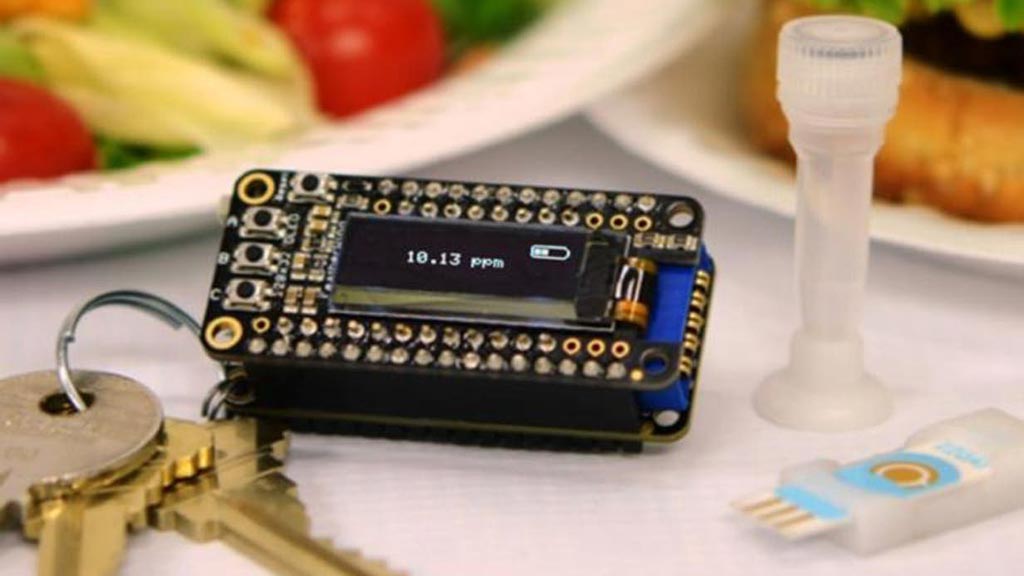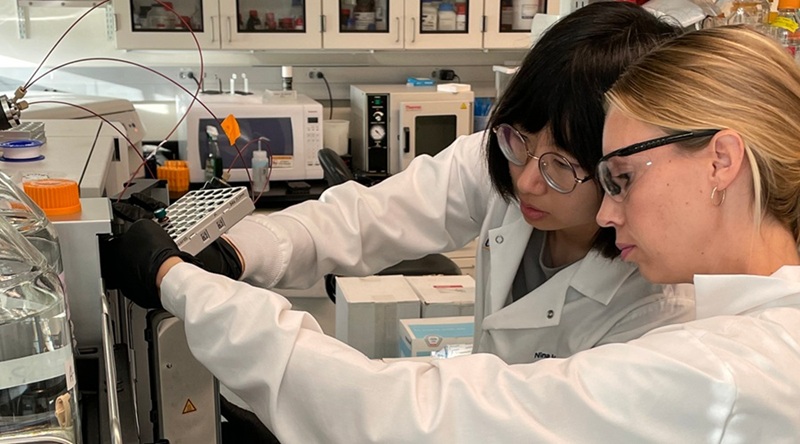Personal Lab Offers Rapid Detection of Food Allergens
|
By LabMedica International staff writers Posted on 06 Nov 2017 |

Image: The iEAT system for onsite antigen detection consists of a pocket-sized detector, an electrode chip, and a disposable kit for allergen extraction. The detector connects with a smartphone for system control and data upload to a cloud server (Photo courtesy of Lin, et al. ACS Nano, August 2017).
Researchers have developed a small, low cost device for individual use that can accurately detect food allergens in less than ten minutes.
Adverse food reactions, including food allergies, food sensitivities, and autoimmune reaction (e.g., celiac disease) affect 5-15% of the population of the USA and remain a considerable public health problem requiring stringent food avoidance and epinephrine availability for emergency events. Avoiding problematic foods is difficult in practical terms, given current reliance on prepared foods and out-of-home meals.
In response to the food allergy problem, investigators at Harvard Medical School (Boston, MA, USA) developed a portable, point-of-use detection technology, that they called "integrated exogenous antigen testing" (iEAT).
The iEAT device consists of three components: (1) a small plastic test tube, (2) a small electronic detection module, and (3) the electronic keychain reader. To perform the test, the user dissolves a small sample of the food in the plastic test tube and then adds magnetic beads that capture the food allergen of interest. A bit of this mixture is loaded onto electrode strips attached to a small module that is then inserted into the electronic keychain reader. The keychain reader has a small display that indicates whether the allergen is present, and if so, in what concentration.
The prototype iEAT system was optimized to detect five major food antigens in peanuts, hazelnuts, wheat, milk, and eggs. Antigen extraction and detection with iEAT required less than 10 minutes and achieved high-detection sensitivities (e.g., 0.1 milligram per kilogram for gluten, 200 times lower than regulatory limits of 20 milligram per kilogram).
The investigators also developed a dedicated cell phone application, which allows the user to compile and store the data collected by testing different foods for various allergens at different restaurants or in packaged foods. The application is set up to share this information online with both time and location stamps indicating when, where, and in what food or dish an allergen reading was taken.
“High accuracy built into a compact system was the key goals of the project,” said contributing author Dr. Ralph Weissleder, professor of radiology and systems biology at Harvard Medical School. “Users can be confident that even if they are sensitive to very low levels, iEAT will be able to give them exact concentrations. Armed with accurate concentration levels they will not have to completely avoid potentially problematic foods, but will know whether an allergen is at a dangerous level for them or a concentration that is safe for them to eat.”
The iEAT device was described in the August 2017 issue of the journal ACS Nano.
Related Links:
Harvard Medical School
Adverse food reactions, including food allergies, food sensitivities, and autoimmune reaction (e.g., celiac disease) affect 5-15% of the population of the USA and remain a considerable public health problem requiring stringent food avoidance and epinephrine availability for emergency events. Avoiding problematic foods is difficult in practical terms, given current reliance on prepared foods and out-of-home meals.
In response to the food allergy problem, investigators at Harvard Medical School (Boston, MA, USA) developed a portable, point-of-use detection technology, that they called "integrated exogenous antigen testing" (iEAT).
The iEAT device consists of three components: (1) a small plastic test tube, (2) a small electronic detection module, and (3) the electronic keychain reader. To perform the test, the user dissolves a small sample of the food in the plastic test tube and then adds magnetic beads that capture the food allergen of interest. A bit of this mixture is loaded onto electrode strips attached to a small module that is then inserted into the electronic keychain reader. The keychain reader has a small display that indicates whether the allergen is present, and if so, in what concentration.
The prototype iEAT system was optimized to detect five major food antigens in peanuts, hazelnuts, wheat, milk, and eggs. Antigen extraction and detection with iEAT required less than 10 minutes and achieved high-detection sensitivities (e.g., 0.1 milligram per kilogram for gluten, 200 times lower than regulatory limits of 20 milligram per kilogram).
The investigators also developed a dedicated cell phone application, which allows the user to compile and store the data collected by testing different foods for various allergens at different restaurants or in packaged foods. The application is set up to share this information online with both time and location stamps indicating when, where, and in what food or dish an allergen reading was taken.
“High accuracy built into a compact system was the key goals of the project,” said contributing author Dr. Ralph Weissleder, professor of radiology and systems biology at Harvard Medical School. “Users can be confident that even if they are sensitive to very low levels, iEAT will be able to give them exact concentrations. Armed with accurate concentration levels they will not have to completely avoid potentially problematic foods, but will know whether an allergen is at a dangerous level for them or a concentration that is safe for them to eat.”
The iEAT device was described in the August 2017 issue of the journal ACS Nano.
Related Links:
Harvard Medical School
Latest Technology News
- Machine Learning Models Diagnose ALS Earlier Through Blood Biomarkers
- Artificial Intelligence Model Could Accelerate Rare Disease Diagnosis
- AI Saliva Sensor Enables Early Detection of Head and Neck Cancer
- AI-Powered Biosensor Technology to Enable Breath Test for Lung Cancer Detection
- AI Model Achieves Breakthrough Accuracy in Ovarian Cancer Detection
- Portable Biosensor Diagnoses Psychiatric Disorders Using Saliva Samples
- Cell-Sorting Device Uses Electromagnetic Levitation to Precisely Direct Cell Movement

- Embedded GPU Platform Enables Rapid Blood Profiling for POC Diagnostics
- Viral Biosensor Test Simultaneously Detects Hepatitis and HIV
- Acoustofluidic Device to Transform Point-Of-Care sEV-Based Diagnostics
- AI Algorithm Assesses Progressive Decline in Kidney Function
Channels
Clinical Chemistry
view channel
Online Tool Detects Drug Exposure Directly from Patient Samples
Doctors often rely on patient interviews and medical records to determine what medications a person has taken, but this information is frequently incomplete. People may forget drugs they used, take over-the-counter... Read more
Chemical Imaging Probe Could Track and Treat Prostate Cancer
Prostate cancer remains a leading cause of illness and death among men, with many patients eventually developing resistance to standard hormone-blocking therapies. These drugs often lose effectiveness... Read moreHematology
view channel
MRD Tests Could Predict Survival in Leukemia Patients
Acute myeloid leukemia is an aggressive blood cancer that disrupts normal blood cell production and often relapses even after intensive treatment. Clinicians currently lack early, reliable markers to predict... Read more
Platelet Activity Blood Test in Middle Age Could Identify Early Alzheimer’s Risk
Early detection of Alzheimer’s disease remains one of the biggest unmet needs in neurology, particularly because the biological changes underlying the disorder begin decades before memory symptoms appear.... Read more
Microvesicles Measurement Could Detect Vascular Injury in Sickle Cell Disease Patients
Assessing disease severity in sickle cell disease (SCD) remains challenging, especially when trying to predict hemolysis, vascular injury, and risk of complications such as vaso-occlusive crises.... Read more
ADLM’s New Coagulation Testing Guidance to Improve Care for Patients on Blood Thinners
Direct oral anticoagulants (DOACs) are one of the most common types of blood thinners. Patients take them to prevent a host of complications that could arise from blood clotting, including stroke, deep... Read moreImmunology
view channel
Routine Blood Test Can Predict Who Benefits Most from CAR T-Cell Therapy
CAR T-cell therapy has transformed treatment for patients with relapsed or treatment-resistant non-Hodgkin lymphoma, but many patients eventually relapse despite an initial response. Clinicians currently... Read more
New Test Distinguishes Vaccine-Induced False Positives from Active HIV Infection
Since HIV was identified in 1983, more than 91 million people have contracted the virus, and over 44 million have died from related causes. Today, nearly 40 million individuals worldwide live with HIV-1,... Read more
Gene Signature Test Predicts Response to Key Breast Cancer Treatment
DK4/6 inhibitors paired with hormone therapy have become a cornerstone treatment for advanced HR+/HER2– breast cancer, slowing tumor growth by blocking key proteins that drive cell division.... Read more
Chip Captures Cancer Cells from Blood to Help Select Right Breast Cancer Treatment
Ductal carcinoma in situ (DCIS) accounts for about a quarter of all breast cancer cases and generally carries a good prognosis. This non-invasive form of the disease may or may not become life-threatening.... Read moreMicrobiology
view channel
Blood-Based Diagnostic Method Could Identify Pediatric LRTIs
Lower-respiratory tract infections (LRTIs) are a leading cause of illness and death worldwide, and pneumonia is the leading infectious cause of death in children under five, claiming the lives of over... Read more
Rapid Diagnostic Test Matches Gold Standard for Sepsis Detection
Sepsis kills 11 million people worldwide every year and generates massive healthcare costs. In the USA and Europe alone, sepsis accounts for USD 100 billion in annual hospitalization expenses.... Read moreRapid POC Tuberculosis Test Provides Results Within 15 Minutes
Tuberculosis remains one of the world’s deadliest infectious diseases, and reducing new cases depends on identifying individuals with latent infection before it progresses. Current diagnostic tools often... Read more
Rapid Assay Identifies Bloodstream Infection Pathogens Directly from Patient Samples
Bloodstream infections in sepsis progress quickly and demand rapid, precise diagnosis. Current blood-culture methods often take one to five days to identify the pathogen, leaving clinicians to treat blindly... Read morePathology
view channel
Rapid Low-Cost Tests Can Prevent Child Deaths from Contaminated Medicinal Syrups
Medicinal syrups contaminated with toxic chemicals have caused the deaths of hundreds of children worldwide, exposing a critical gap in how these products are tested before reaching patients.... Read more
Tumor Signals in Saliva and Blood Enable Non-Invasive Monitoring of Head and Neck Cancer
Head and neck cancers are among the most aggressive malignancies worldwide, with nearly 900,000 new cases diagnosed each year. Monitoring these cancers for recurrence or relapse typically relies on tissue... Read more
Common Health Issues Can Influence New Blood Tests for Alzheimer’s Disease
Blood-based tests for Alzheimer’s disease are transforming diagnosis by offering a simpler alternative to spinal taps and brain imaging. However, many people evaluated at memory clinics also live with... Read more
Blood Test Formula Identifies Chronic Liver Disease Patients with Higher Cancer Risk
Chronic liver disease affects millions worldwide and can progress silently to hepatocellular carcinoma (HCC), one of the deadliest cancers globally. While surveillance guidelines exist for patients with... Read moreTechnology
view channel
Machine Learning Models Diagnose ALS Earlier Through Blood Biomarkers
Amyotrophic lateral sclerosis (ALS) is a rapidly progressive neurodegenerative disease that is notoriously difficult to diagnose in its early stages. Early symptoms often overlap with other neurological... Read more
Artificial Intelligence Model Could Accelerate Rare Disease Diagnosis
Identifying which genetic variants actually cause disease remains one of the biggest challenges in genomic medicine. Each person carries tens of thousands of DNA changes, yet only a few meaningfully alter... Read moreIndustry
view channel
Abbott Acquires Cancer-Screening Company Exact Sciences
Abbott (Abbott Park, IL, USA) has entered into a definitive agreement to acquire Exact Sciences (Madison, WI, USA), enabling it to enter and lead in fast-growing cancer diagnostics segments.... Read more

















